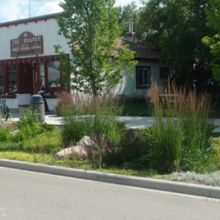Image set

Related services
Related sectors
Related regions
Opening article section
Article section
Lead
Rich text
Instead, water flows quickly across them - picking up pollutants along the way - and then enters ditches and storm drains, which often empty directly into local waterways. This untreated water could potentially impact residents’ health and endanger their community’s animal, marine and plant life.
However, there are new land development approaches that can minimize the risk this wastewater poses to our communities and the natural environment. One notable option is low-impact development (LID), a method that works with nature to manage stormwater runoff where and when it falls.
A double-pronged approach
The LID approach works on two fronts. It encourages the preservation and recreation of natural landscape features, while simultaneously minimizing the quantity and extent of hard, impermeable surfaces. This double-pronged approach therefore encourages the creation of site drainage installations that are both functional and appealing.
The LID methodology represents a sea change in the way stormwater is managed. It encourages the introduction of various natural landscaping and design practices that slow down rainfall and collect it in containers. Common LID features include green roofs, bioretention, rain gardens, sidewalk planters, curb extensions, street trees supported by soil cells, permeable (porous) pavements, and rain barrels or cisterns.
A typical installation consists of a variety of small trees, shrubs, grasses, and other vegetation, planted in permeable soil. This creates a self-contained planter capable of absorbing precipitation as it falls or melts, thus diverting it away from ditches and storm drains. This system collects the water as close as possible to where it falls, and also treats it like a valuable resource rather than a waste product.
Ultimately, these practices improve the quality and decrease the volume of stormwater entering a community’s drainage systems and potentially, its waterways. In addition, many of these practices add attractive amenities to a neighbourhood and can even help boost local property values.
A successful collaboration with the City of Calgary
LID is a relatively new approach to stormwater management in Western Canada. As a result, monitoring these practices’ effectiveness over time is a crucial assessment and analytical step.
MPE (an Englobe company) is at the forefront of this emerging practice. Our firm has significant experience in the design, construction and ongoing monitoring of LID installations. Moreover, Englobe has also led and collaborated in developing CSA standards related to bioretention and flood resiliency in both new and established communities.
Notably, MPE conducted stormwater monitoring and analysis between 2016 and 2019 in order to assess LID performance and associated benefits, and used this data to develop LID guidelines and standards for the City of Calgary. For this project, we collaborated with the City to develop monitoring systems to help understand and measure the performance of its LID installations.
We installed a flume measuring device inside a storm drain. The device provides continuous flow monitoring to track discharge events and assess the annual runoff volume from an industrial catchment area. This data can then be used in correlation with actual rainfall and climate data to measure success of the installations related to water quantity and quality treatment, operational performance and identifying the most adaptable vegetation species. This helps predict future performance outcomes and guide the design of future LID installations. This project has highlighted the need and value of monitoring to gain hard evidence, with the City looking to monitor other LID installations.
The wave of the future
Green stormwater infrastructure and low-impact development practices are gaining traction in Canada and elsewhere as an effective, low-cost and sustainable addition to traditional stormwater management methods. In fact, by enabling precipitation to be soaked up where it falls, the use of LID practices and structures like those in Calgary may even reduce a municipality’s overall stormwater management costs. It certainly reduces the volume of untreated stormwater entering the community’s drainage systems and potentially affecting plant, animal and human health.
With the advent of more frequent severe weather events caused by climate change, LID’s importance will become even more pronounced in the coming years. By implementing these principles and practices, a community can manage water in a sustainable way that reduces the impact of the built environment and promotes the natural movement of water on its territory.
Media
Image set

Media
Image set

Media
Image set
